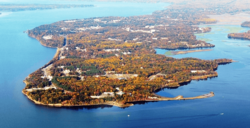Indian Head Naval Surface Warfare Center facts for kids
Quick facts for kids Naval Support Facility Indian Head |
|
|---|---|
| Part of Naval Support Activity South Potomac | |
| Near Indian Head, Maryland in the United States | |

An aerial view of NSF Indian Head
|
|
 |
|
|
Location in Maryland##Location in the United States
|
|
| Coordinates | 38°35′18.88″N 77°10′9.12″W / 38.5885778°N 77.1692000°W |
| Type | Naval Support Facility and military proving ground |
| Site information | |
| Owner | Department of Defense |
| Operator | US Navy |
| Controlled by | Naval District Washington |
| Condition | Operational |
| Site history | |
| Built | 1890 |
| In use | 1890 – present |
| Garrison information | |
| Current commander |
Captain Steve Duba |
| Garrison | Naval Surface Warfare Center Indian Head Division |
The Naval Surface Warfare Center, Indian Head Division (often called NSWC IHD) is a special place for the United States Navy in Charles County, Maryland. It's like a big science lab and factory all rolled into one! This facility is part of the Naval Sea Systems Command (NAVSEA). It is one of ten divisions of the Naval Surface Warfare Center.
The main job of NSWC IHD is to study, create, test, and produce "energetics." This fancy word means things like explosives, propellants (what makes rockets go), and pyrotechnics (like fireworks, but for military use). They also work with other special chemicals and fuels. These materials are used in propulsion systems and ordnance, which are parts of weapons.
The U.S. Navy has been in Indian Head since 1890. That's when a person named Robert B. Dashiell was sent there. His job was to set up a center for naval ordnance, which means Navy weapons. Dashiell worked there from 1890 to 1893. During World War I, this place was known as the Naval Proving Ground, Indian Head. A proving ground is where new weapons are tested.
NSWC Indian Head is the largest facility of its kind for the United States Department of Defense (DoD). It focuses on all types of energetics. More than 1,900 people work here. Over 850 of these are scientists, engineers, and technicians. They create and maintain explosives, propellants, and other high-energy chemicals. These are then used in different weapons.
This division has the most Ph.D. scientists working on energetics. Many of them are experts in creating new chemicals. Others are specialists in how explosions work. They also have scientists who develop new material formulas.
The work at NSWC Indian Head covers many stages. They do basic research to discover new things. They also develop new technologies and show how they work. They create prototypes (first versions) and engineer new products. They help buy and produce these materials. They also investigate accidents and failures. Finally, they help with surveillance and safely getting rid of old materials.
NSWC Indian Head is the U.S. Navy's main technical expert in energetics. They handle over 60% of all the Navy's work in this area. They have a great track record, with 13 Navy-approved explosives. These explosives are used in 47 different weapons. These weapons are used by the Navy, Army, Air Force, and Marine Corps. In fact, 75% of all explosives used in U.S. weapons were first developed at NSWC Indian Head.
The main site for NSWC IHD is the Naval Support Facility Indian Head. It's a large area of 3,500 acres. This area is on a peninsula along the Potomac River in southern Maryland. It's at the very end of the Indian Head Highway. NSWC IHD also has other locations. These include places in McAlester, Oklahoma; Colts Neck, New Jersey; Ogden, Utah; Louisville, Kentucky, and Picatinny, New Jersey.
What NSWC Indian Head Does
NSWC Indian Head has many important abilities and tasks. They work on different parts of energetic systems.
- Research and Development: They research, develop, test, and evaluate energetic systems. This includes how they are bought, engineered, and kept in service.
- Manufacturing: They work on making energetic systems and materials. This includes scaling up production and improving manufacturing methods.
- Special Devices: They create and work with special devices. These include things like cartridge-activated devices (which use a small explosive charge to do something). They also make cutters, sounding devices, and other special tools.
- Training Equipment: They develop and maintain weapon simulators and trainers. They also create training programs and equipment for testing and fixing things.
- Safety and Environment: They research safety for energetics. They also work on environmental technology. This includes how to package, handle, store, and transport these materials safely.
- Ammunition Engineering: They engineer and maintain conventional ammunition.
- Gun Systems: They help keep gun systems working. They also test them and provide support for their logistics.



